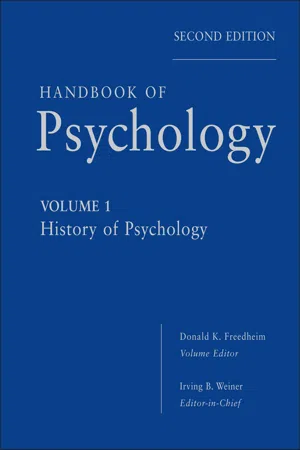Psychology
Primary Emotions
Primary emotions are the basic, universal emotions that are considered to be innate and experienced by all humans. These emotions include happiness, sadness, fear, anger, surprise, and disgust. They are thought to have a direct and immediate impact on behavior and are often the foundation for more complex emotions.
Written by Perlego with AI-assistance
Related key terms
4 Key excerpts on "Primary Emotions"
- eBook - ePub
Companion Encyclopedia of Psychology
Volume One
- Andrew M. Colman(Author)
- 2018(Publication Date)
- Routledge(Publisher)
Some theorists have suggested that there is a small set of Primary Emotions, based on the genetic inheritance of the species or the commonalities in human development (see Table 1). For example, Ekman and Friesen (1971) suggested that there are six basic biologically programmed emotions: happiness, sadness, fear, anger, surprise, and disgust, each with its own distinctive facial expression. In the primary emotion view, other non-Primary Emotions are thought to be blends of the basic ones. However, the fact that psychologists have disagreed about which emotions are basic (and about whether states such as surprise are even emotions, let alone basic emotions) tends to undermine the credibility of the view that certain states are basically, irreducibly, and inescapably emotional. Indeed, some psychologists have denied that there is any good reason to suppose that there are basic emotions at all (Ortony & Turner, 1991). Having considered the various examples of emotion, there still remains the question of how these examples themselves should be defined. Like the concept of emotion in general, particular emotional terms also seem to have prototypical rather than classical definitions. For example, saying that someone is angry implies a variety of claims about that person's experience, expression, and likely behaviour, but not all of these need apply for anger to be a valid description of the state. Next I shall look at the different components of emotion, before considering the ways in which these aspects are interrelated and build the complete experience of an emotional state. Components of Emotion Psychological research into emotion has focused on four variables that are associated with emotional experience. I shall consider each of these factors in turn as characteristics of emotional experience. The four kinds of phenomena are the following: situational evaluations, bodily changes, expressive behaviours, and motivated actions - eBook - ePub
Revolt from the Middle
Emotional Stratification and Change in Post-Industrial Societies
- Jonathan H. Turner(Author)
- 2017(Publication Date)
- Routledge(Publisher)
3Emotional DynamicsWired to Be Emotional
Primary Emotions
One of the most unique features of humans is their neurological wiring for enhanced emotionality. There is an interesting evolutionary and neurological story for why humans became so emotional (see the appendix at the end of this chapter), but my concern here is understanding how the breadth and potential intensity of emotions are part of an emotional stratification system that affects why and how people in a society become mobilized for conflict and institutional change. All scholars who study human emotions agree that, at the very least, humans are hard-wired in their neurology to experience and express four Primary Emotions: satisfaction-happiness, assertion-anger, aversion-fear, and disappointment-sadness. Most scholars add another emotion or two to this list of Primary Emotions—emotions such as disgust, surprise, or expectancy—but there is little consensus among all those who have developed typologies of emotions for these additional emotional states (see Turner and Stets, 2005:14–15 for a review of various typologies of Primary Emotions). I have stated these four Primary Emotions that all scholars agree upon as a continuum from a low to higher intensity; and in Table 3.1 , I offer examples of varying levels of intensity for these Primary Emotions. Thus, as is evident, humans experience and express a rather large variety of Primary Emotions.One of the most interesting aspects of Primary Emotions in humans and other higher mammals is that three quarters are negative (i.e., anger, fear, and sadness) and only one (happiness) is positive. The implication of this fact is that humans and other mammals are more prone to emit negative than positive emotions, which obviously would be disruptive to social relations. Among most mammals, there are strong bioprogrammers among members of species for group formation, even when emotions turn negative; in contrast, and as outlined in the Appendix, humans lack these very bioprogrammers, and so it is always problematic in human social relations when negative emotions are aroused. One effect of adding more variants of the Primary Emotions listed in Table 3.1 - eBook - ePub
- (Author)
- 2012(Publication Date)
- Wiley(Publisher)
Consistent with the idea of emotions as action impulses is the recent work on emotional impacts on judgment and decision making. Following a functionalist tradition, the underlying notion is that certain emotions should predispose particular desires and preferences, with approach versus withdrawal being a key dimension (a dimension related to, but not identical with, pleasant versus unpleasant) (Davidson, 1983). Neuroscientific investigations have looked for the correlates of the different emotional states, focusing in particular in asymmetries in prefrontal activation (Harmon-Jones, 2004). Work has also examined people's willingness to take risks, often in laboratory gambling paradigms, after different emotional inductions (Loewenstein & Lerner, 2002). However, while this work seems in some ways to get at basic emotional states, the inductions—for example, using emotional words in a Stroop paradigm, looking at smiling versus frowning faces, and the like—seem likely not to induce actual emotions, but rather to prime thoughts of them.Many of the mental/central theories are descendants of a line of thought going back to Descartes and his postulation of fundamental, unanalyzable emotions. However, some 300 years later there has been no agreement on what the number of basic emotions is. Ortony and Turner (1990) note that the number of basic emotions can vary from 2 to 18, depending on which theorist you read. If, as is being increasingly argued nowadays, there is an evolutionary basis to the Primary Emotions, should they not be more obvious? If basic emotions are a characteristic of all humans, should the answer not stare us in the face? The emotions that one finds in most lists are heavily weighted toward the negative emotions, and love and lust, for example, are generally absent (see also Mandler, 1984).Some approaches, giving up on identifying basic, fundamental emotions, have instead suggested that there are fundamental dimensions of emotions. Theories have taken various forms, including circumplex models (e.g., Russell, 1980), with arousal and pleasantness as the two dimensions, though others have other dimensions, such as approach and avoidance. However, finding dimensions that are useful for organizing emotional states is not at all the same as finding the true underlying dimensions, any more than discovering that novels can be sorted by how long they are and the extent to which they rely on suspense reveals the basic nature of fiction. All novels could be positioned in such a space, and it might be useful to do so, but it does not capture the underlying truth of novels. Finding dimensions of emotion gets one no closer to finding what is basic than do lists of 8 or 18 irreducible states. - eBook - ePub
Shame
The Exposed Self
- Michael Lewis(Author)
- 1995(Publication Date)
- Free Press(Publisher)
The second mechanism that can be evoked to explain why John focused on fatigue rather than sadness has to do less with a topology of components of the self in conflict or the mechanism of repression and more with simple learning processes. I have suggested elsewhere that during socialization children are given specific verbal labels and are responded to in a unique fashion when they exhibit certain emotional behaviors in certain contexts.6 Parental response to emotional states and their associated behaviors should result in children learning to think about their emotional states. Parents may in effect teach children to have an awareness not in agreement with their internal states. For example, as a child John may have exhibited certain behaviors in a situation of loss. When he did, his parents informed him that these behaviors meant that he was tired, not sad. In other words, past experience may be capable of shaping people’s self-awareness about an emotion, even to the extent of producing an awareness that is idiosyncratic in relation to the actual emotional state. This type of learning is likely to account for differences termed pathological. Perhaps it also accounts for familial, group, and cultural differences in emotional experience.To summarize, “feeling” means having an emotional state, and also means being aware of that emotional state. These meanings are too often assumed to be the same. All emotions can be experienced. What we need to consider now, however, is how emotions differ from one another.Primary Versus Secondary Emotions
The notion of primary, or basic, emotions has a long history dating back to Descartes’s six primary passions and to Spinoza’s three primary affects. The idea that there is a basic set of emotions grows out of the idea of human instincts or propensities. If they are basic, prewired, or genetically given, they have to be limited in number. While we recognize an enormous variety of emotions we describe in giving accounts of our lives, the existence of each one as a unique and discreet “wiring” is too burdensome a characterization of the nervous system. Instead of positing this complex set of emotions, most theorists have argued that there are only a select number of basic, primary, or pure emotions, and that all the others to which we refer are mixes of these original few.
Learn about this page
Index pages curate the most relevant extracts from our library of academic textbooks. They’ve been created using an in-house natural language model (NLM), each adding context and meaning to key research topics.



